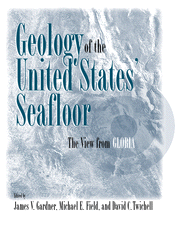Book contents
- Frontmatter
- Contents
- Contributors
- Foreword
- Introduction
- Part I The GLORIA System and Data Processing
- Part II U. S. East Coast EEZ
- Part III Gulf of Mexico and Caribbean EEZ
- Introduction
- 5 Breaching the Levee of a Channel on the Mississippi Fan
- 6 Morphology of Carbonate Escarpments as an Indicator of Erosional Processes
- 7 Sedimentary Processes in the Salt Deformation Province of the Texas-Louisiana Continental Slope
- 8 Sedimentary Processes in a Tectonically Active Region: Puerto Rico North Insular Slope
- 9 A Review of the Tectonic Problems of the Strike-Slip Northern Boundary of the Caribbean Plate and Examination by GLORIA
- Part IV U. S. West Coast EEZ
- Part V Alaskan EEZ
- Index
7 - Sedimentary Processes in the Salt Deformation Province of the Texas-Louisiana Continental Slope
Published online by Cambridge University Press: 25 January 2010
- Frontmatter
- Contents
- Contributors
- Foreword
- Introduction
- Part I The GLORIA System and Data Processing
- Part II U. S. East Coast EEZ
- Part III Gulf of Mexico and Caribbean EEZ
- Introduction
- 5 Breaching the Levee of a Channel on the Mississippi Fan
- 6 Morphology of Carbonate Escarpments as an Indicator of Erosional Processes
- 7 Sedimentary Processes in the Salt Deformation Province of the Texas-Louisiana Continental Slope
- 8 Sedimentary Processes in a Tectonically Active Region: Puerto Rico North Insular Slope
- 9 A Review of the Tectonic Problems of the Strike-Slip Northern Boundary of the Caribbean Plate and Examination by GLORIA
- Part IV U. S. West Coast EEZ
- Part V Alaskan EEZ
- Index
Summary
Abstract
GLORIA sidescan sonar imagery, multibeam bathymetry, and seismic-reflection data collected from a 102-by-111-km area of the Texas-Louisiana continental slope were used to identify the surficial and deeper features that define sedimentary processes that have acted on this continental margin, which has been intensely deformed by salt tectonics. Distinctive high-backscatter patterns on the GLORIA images outline areas that appear to be associated with rough seafloor around hydrocarbon vents and areas of mass wasting. Integration of the images with the bathymetric and seismic-reflection data show that the vent-related features are associated with faults and diapirs suggesting that these are the conduits through which deeper hydrocarbons may be escaping to the seafloor. In addition, mass wasting deposits are found along the base of the Sigsbee Escarpment, which marks the edge of the salt province, but are absent (or below the resolution of the GLORIA system) below slopes within the salt province that are equal in steepness to the Sigsbee Escarpment. The distribution of mass wasting deposits suggests that, in the recent past, the Sigsbee Escarpment has been tectonically more active or has been subjected to different processes than the remainder of the salt province behind it.
Introduction
The continental slope south of Texas and Louisiana in the Gulf of Mexico is unique within the U.S. Exclusive Economic Zone because of the massive Jurassic-aged Louann salt which underlies it (Salvador 1991).
- Type
- Chapter
- Information
- Geology of the United States' SeafloorThe View from GLORIA, pp. 109 - 122Publisher: Cambridge University PressPrint publication year: 1996



